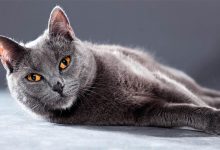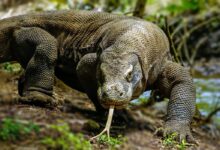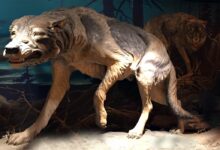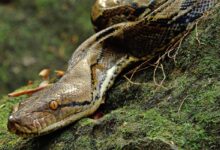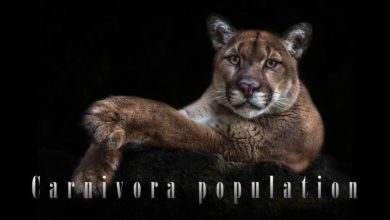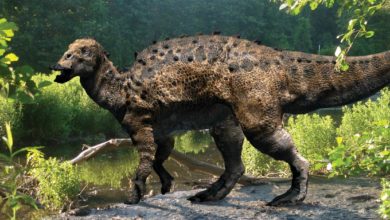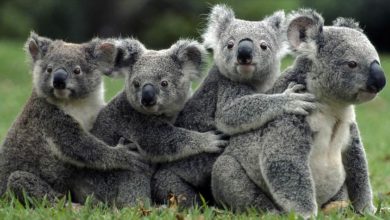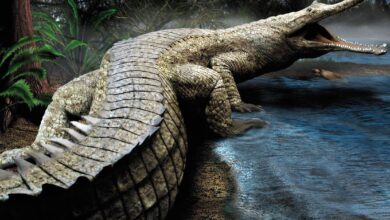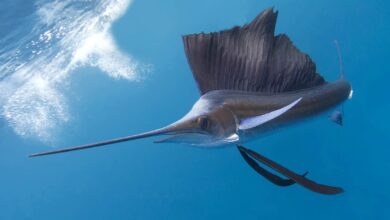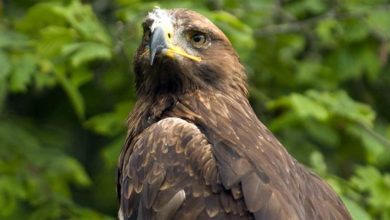Saltwater crocodile (Crocodylus porosus)
Saltwater crocodile – the largest modern crocodile
There are signs in Kakadu National Park warning people of the attacks of saltwater crocodiles. It may seem like an exaggeration, but due to its efficiency, strength, size and temperament, the saltwater crocodile has attacked people more than once, treating them in their area as food. If someone / something falls into his strong jaws once, there is no chance of freeing them…
Classification
- Class: Reptiles
- Subclass: Diapsid
- Order: Crocodilia
- Family: Crocodylidae
- Genus: Crocodylus
- Species: Saltwater crocodile (Crocodylus porosus)
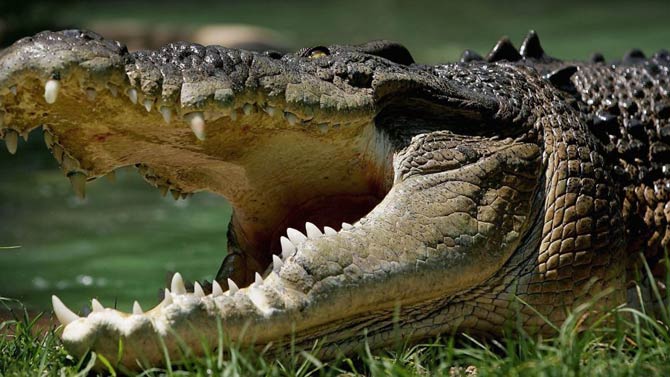
Habitats
In comparison to other modern crocodiles, its habitats can be found on the biggest number pf territories. It occurs on the east coast of India, in a majority of South-east Asia, up to the Northern Australia. It may be found on the east coast of Africa and coastal waters of Japan.
Australia
In northern Australia (the Northern Territory, Western Australia, Queensland) its population is the biggest, especially by the Darwin River Dam. 16-feet specimens are common there.
India
In India it is one of three crocodiles genera, ex to Mugger crocodile (Crocodylus palustris) and a piscivorous gharial (Gavialis gangeticus).
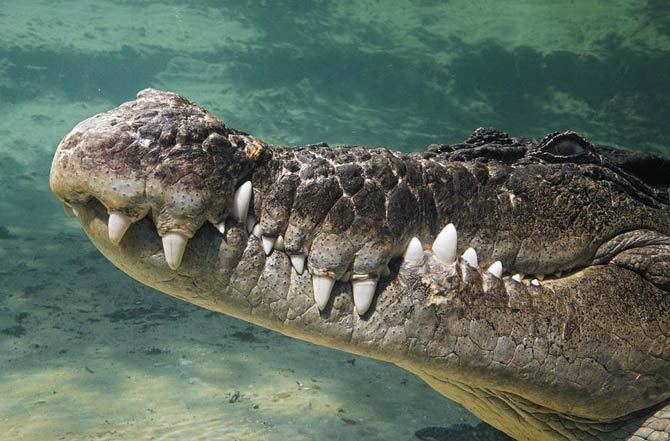
New Guinea
In New Guinea it lives in almost all rivers, including their estuaries. shares the place of occurrence with a less aggressive New Guinea crocodile (Crocodylus novaeguineae).
Isles
It may be found on Bismarck Archipelago, Kai Islands and Aru Islands, on Maluku Islands and on many other isles of this region, including Timor and on most of the islands located near the Torres Strait.
Habitats
During the rainy season, saltwater crocodile spends most of its time in the fresh-water marshes and the rivers. When the dry season comes, it moves to the estuaries and sometimes it swims into to the sea. Saltwater crocodiles compete for territories – especially, for fresh-water brooks and streams. Smaller males are forced to choose the less attractive water bodies, including the oceans. It is due to the fact that the population is quite numerous – living from the coasts of India, up to the northern Australia. Sometimes crocodiles have specific preferences when it comes to their habitats, e.g. The Sea of Japan.

Characteristics
Appearance
It has much broader snout than other crocodiles. It also has one of the longest snout, e.g. longer than the Mudder crocodile’s. It has fewer armor plates on the neck than its cousins. However, there is a pair of ridges running from the eyes to the center of the snout. The scales are oval, and the scutes are much smaller than in case of other crocodiles.
Adult specimens have broad, massive body, usually much more massive than its cousins. It may be sometimes classified as the alligator, because of the differences in the body structure. It has a huge head (the skull is 30 in long!), and the mandible is 40 in long.
It has long teeth. The longest one, located in the front of the mandible, is approx. 9 cm (3.5) long.
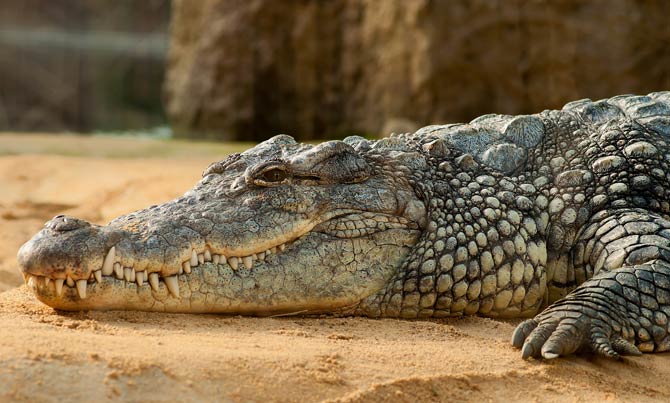
Coloration
Young crocodiles are light-yellow and have black stripes and markings on the body. The coloration changes once the juveniles grow up. Adult specimens are usually dark-green and grey, with some lighter, brown or grey markings. There are several coloration patterns – some specimens are very light, while other are nearly completely black.
The bottom line is white or yellowish, regardless the age. There are also stripes on the bottom line. The tail is grey and has darker markings.
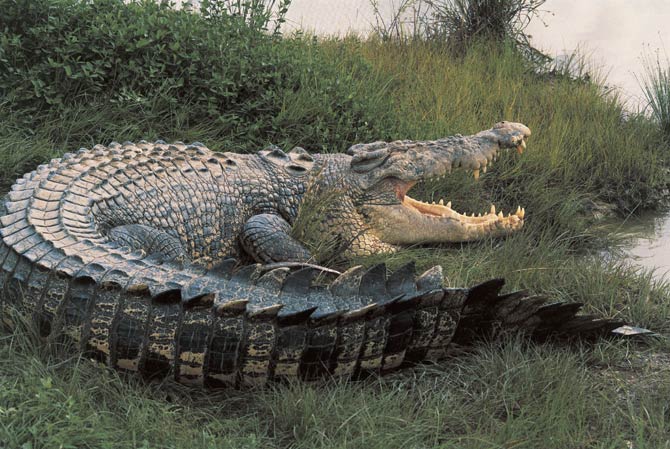
Size – weight and length
Hatchlings are 25 – 30 cm (10 to 12 in) and weigh approximately 70 g (0.15 lb). When they turn the age of 2, they are already 100 cm (40 in long) and weigh 2.5 kg (5.5 lb). Males become sexually mature when they are 3.3 m (11 ft) long, which is around the age of 16. Females are grown up when they achieve 2.5 m (8 ft), which is when they are 12 – 14 old.
Adult males are usually 4.3 – 5.2 m (14 – 17 ft) long and weigh from 400 – 1000 kg (882 to 2000 lb). Older males may sometimes be more than 6 m (20 ft) and weigh more than 1 000 kg (2200 lb).
Because of the excessive poaching in the 20th century, the 7 m (23-feet) specimens are nowadays very rare. It takes a lot of time to grow to such an impressive size.
Huge specimens are rare also because the genes responsible for big size have been eliminated from the genetic pool due to the trophy hunting. Fortunately, many habitats were brought back and the poaching decreases. Therefore, there have been more and more huge crocodiles, especially in an Indian state Orisha.
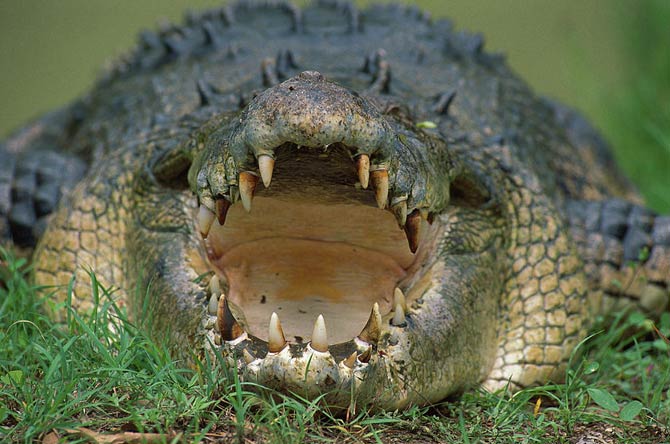
Uneven weight gain
Crocodile’s body mass grows proportionally to the length, but the growth is not constant – more than 6 m (20-feet) long crocodiles may weigh two times more than its 5 m (16-feet) brothers.
Crocodiles’ weight may vary significantly depending on their health condition and the age – older specimens are usually heavier, because they have the access to the territories, which are richer in food.
There is a visible sexual dimorphism within this genus in comparison to all modern crocodiles – the females are much smaller than the males. An average female is 2.3 – 3.5 m (7.5 to 11.5 ft).
The females, which are 3m (10 ft), like e.g. Connie and Cookie from Australian Zoo, weigh only 150 kg (331 lb), and those, which are shorter than 3m (10 ft) weigh from 80 – 100 kg (176 to 220 lb). The biggest recorded female was 4.2 m (14 ft), which in comparison to the longest males looks ridiculous.
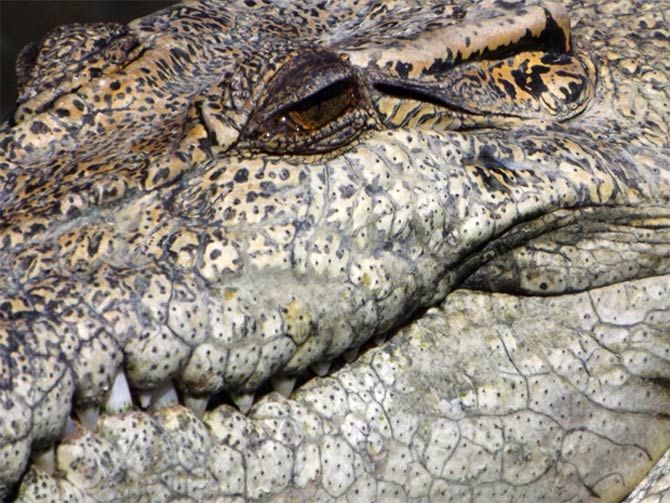
Diet, hunting methods and preys
Just like a majority of crocodiles, saltwater crocodile is not very picky 🙂 its choice depends on the place of its occurrence. What is interesting, saltwater crocodile can live without any food for a long time.
Because of its size, it usually hunts for bigger animals. Juveniles choose smaller preys, e.g. small fish, frogs, insects or water invertebrates.
Juveniles prefer salt-water fish, amphibians, crustaceans, molluscs, e.g. big snails and cephalopods, birds, small and medium mammals and other reptiles (snakes, lizards).
Powerful adults usually choose big animals, however they also snack some smaller animals, like big mud crab from the genus Scylla, especially when they live in mangroves. In Australia, they also eat emus and water birds, wading birds and bats, which approach the surface of the water.
Among mammals, juveniles choose small ungulates, like Indian hog deer, crab-eating macaque, gibbons, porcupines, macropods, mongoose, viverrids, flying foxes, hares, badgers, fishing cats or greater mouse-deers.
Adult crocodiles hunt for bigger deers, such as axis deer or barking deer. Moreover, saltwater crocodile catches boars, tapirs, monkeys, kangaroos, dingos, dholes, jackals, orangutans, turtles, pythons, monitor lizard, antelopes (serow, nilgai) or big bovines like bantengs, water buffalo and even gaurs.
As a fresh-water species, it may hunt for bony fish, sea snakes and sea turtles during the breeding season, when those potential preys approach the coast.
In general, all animals that approach saltwater crocodile, may become its potential preys. With its strength and short-temper, it is even able to kill Sun bear or leopard.
Water buffalo and gaur weigh more than 1 ton and are considered the biggest ever caught preys of saltwater crocodile.
The only animal, which saltwater crocodile would not be able to catch is the Asian elephant. However, it was able to drag a 1-ton Suffolk Punch stallion into the water. Moreover, in 2011 it attacked the Bengal tiger.
Thanks to its sharp teeth, it is perfectly capable of biting its prey and attaching strongly to its meat. However, its teeth are not adapted to cutting the meat. A small animal is simply swallowed whole while the bigger is dragged into the water, which leads to the drowning.
After killing its prey, saltwater crocodile perform a ”death rolling” – it turns around within its own axis in order to twist off a part of the meat. It may also jerk its head while turning around.
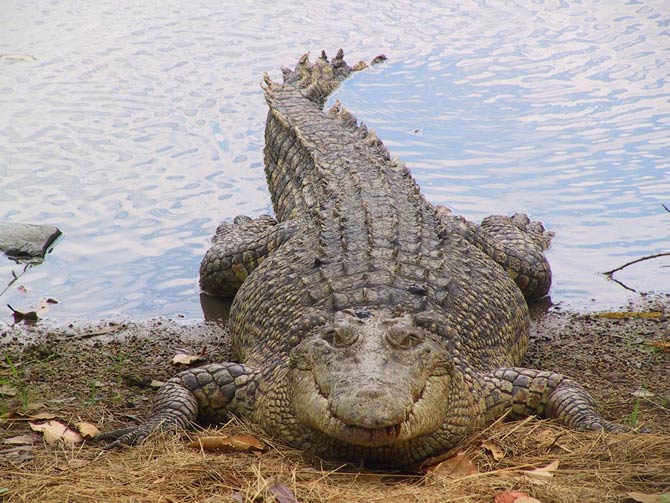
Jaws – a mortal bite. Strong or weak?
Saltwater crocodile has the most powerful bite among all land animals. It is able to crash a skull of adult bovine. It was indicated in the laboratory conditions that a 17-feet reptile can clench its jaws with a power of 16,460 N (1.68 ton/cm2). It is therefore better than 13-feet American alligator which clenches its jaw with a power of 9,452 N (approx. 964 kg/cm3)
Because the crocodiles’ anatomy has slightly changed for 80 million years, its current power of jaws may be estimated on the basis of the extinct species, e.g. 11-12 meters Deinosuchus, whose bite force was approx. 103 000 N (up to 10.5 tons/cm2)
For more information about the power of jaws of modern and extinct animals, see the article T.rex fact and myths.
Where does the strength of the crocodile’s jaws come from?
Why are crocodile jaws so strong?
There is a lot of space in the skull for jaw muscles, which can be seen by the convexities on the sides of the head. The muscles themselves are very hard, almost like bones, therefore a majority of crocodiles’ jaws are adapted to strong clenching.
Although the muscles responsible for closing the snout are very strong, those responsible for its opening are small and weak, therefore, it is easy to overpower saltwater crocodile with a duct tape.
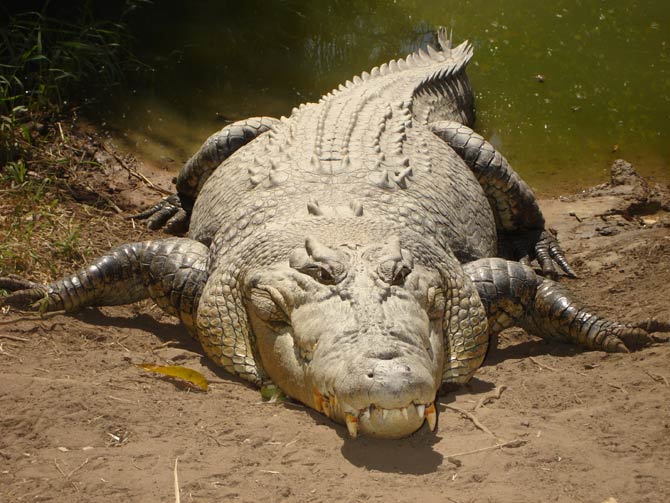
Lifestyle
Saltwater crocodile may be distinguished from other species by its choice of habitat – it usually live in salt water bodies.
Saltwater crocodiles, just like its cousins, have salt glands located near the eyes, which help it survive in salt water.
Saltwater crocodile is also called marine crocodile – what suggests that it moves through the territories between the seas and the rivers or that it can swim through the sea.
Saltwater crocodile has one thing in common with the migratory birds – it uses the ocean’s streams during swimming in order to save the energy (migratory birds use so called thermal column, which enable them to glide. – e.g. albatross)
From twenty specimens with satellite’s transmitter attached to their body, eight swum into the ocean. One of them has traveled 590 km (366 miles) in 25 days. To compare, other crocodiles swum 411 km (255 miles) in 20 days.
Ocean currents
Saltwater crocodile needs ocean currents to move through the oceans and it is able to stay in the bay for a long time and wait for a proper current to come. It often migrates down and up the water systems.
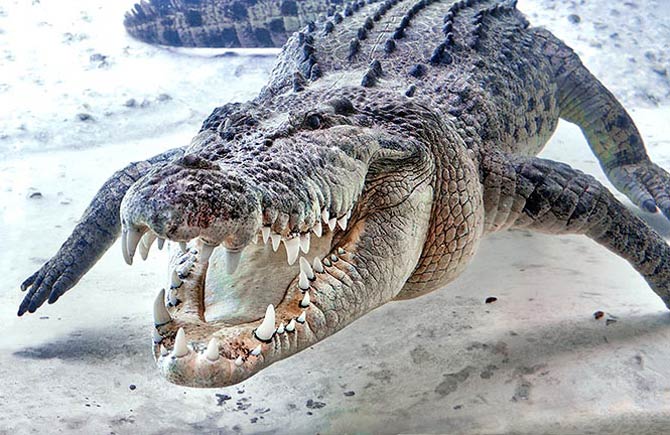
An antisocial reptile
A majority of crocodiles are sociable and share their habitats and food with other crocodiles. In contrast, saltwater crocodile is territorial. Adult males share their territory only with females, in order to get rid of rivals. They reproduce during the wet season, and they lay their eggs in the mud, covering them with plants. The female guards the nest and the young from predators.
Lethargy
Saltwater crocodile is usually lethargic, but it is not a fault. Thanks to this trait, it can survive a long time without food. It tends to swim slowly in the water or seat in the sun for a majority of time. It hunts during night.
Activity dependent on the season
Australian specimens are more active in the summer, when they swim a lot. They become less active during winter, when they rather sit in the sun and rest. Nonetheless, Saltwater crocodile spends less time on land in comparison to other crocodiles – if it comes ashore, it is only in order to bask in the sun.
They are often covered in barnacles, what indicates that they spend lots of time in the sea.

Fast and agile
Despite the fact that it is usually lethargic, it is actually a fast and agile predator. Its best weapon is the ability to take the prey coming to the watering place by a surprise. It swims with a speed of 24- 29 km/h (18 mph) on short distances, therefore it is three times faster than a human.
In land, it moves with a speed of 3,2 – 4,8 km/h (2 – 3 mph), hence it is myth that it can swim as fast as a race horse. It is worth remembering that thanks to its legs and its tail, its speed may be dangerous.
Small brain
Despite the fact that its brain is much smaller than in case of the mammals, it is actually able to learn complex tasks. It observes the migratory tracks of its preys and may even know the forms of communication that we do not know of.
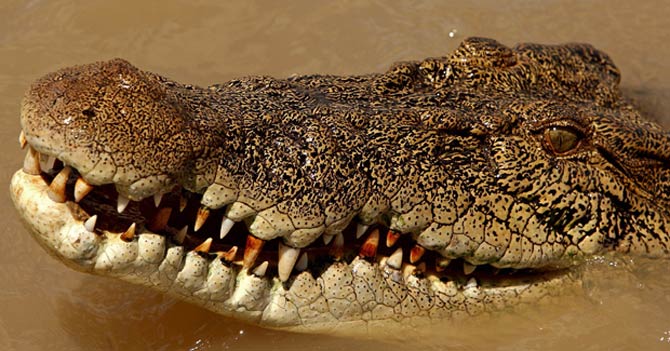
Reproduction
The courtship takes place during the rainy season, when the level of waters is the highest.
In Australia, males and females engage in a courtship between the September and the October, and the eggs are laid between the November and the march. The future mother chooses the nest and then both parents protect it. It is usually located on the shores of the tidal rivers or in fresh-water areas.
Nests, eggs and hatchlings
The nest consists of mud and plants. It is usually 175 cm (5.7 ft) long and 53 cm (20 in) tall. The female lay 40 to 60 eggs, however there are sometimes 90 of them, They are 5 – 8 cm (2 – 3) in and weigh 113 g (0,25 lb). The incubation lasts 80 – 98 days, however the eggs may be lost in flood or took by the predators.
What determines the gender of crocodiles?
As it is in the case of all crocodiles, the sex depends on the temperature of incubation and environment. Females are born when the temperatures are relatively low, males when the temperatures are high.
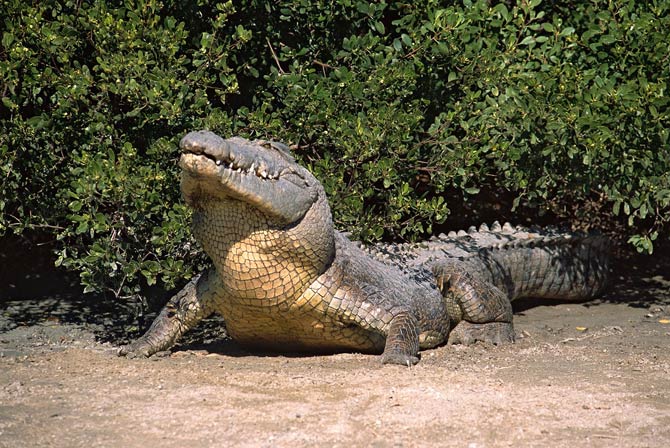
Remarkable level of parents’ care
The mother has a strong caring instinct towards its children: it responses to the squeaks, „talks”to hatchlings and even gently roll the eggs in its snout, in order to help them hatch.
After the hatch, the female takes the children to the water with its snout, just like Nile crocodile (Crocodylus noloticus) and American Alligator (Alligator mississippiensis) do and stay with its children for several months. Even though the hatchlings are protected by its mother, they often die as a result of predators’ and other crocodiles’ attacks.
Longevity
Juveniles leave their nests when they are eight months old. When they are two years old, they become territorial. Achievement of sexual maturity takes many years. However, it is worth being patient, taking into consideration how long some specimens can live – 70 and even 100 years.
Adults do not have enemies, but juveniles may be preys of monitor lizard, predacious fish, water birds, crocodiles and other big predators. Juveniles are also being attacked by tigers and leopards. However, they rarely encounter the felines because they avoid the territories where saltwater crocodiles may be found.
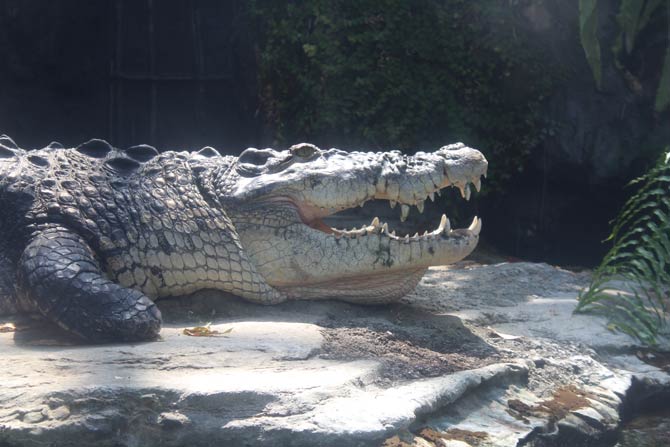
Detailed information / size / dimensions
Saltwater crocodile (Crocodylus porosus)
- Body length:
- males: 4,3 – 5,2 m 15 – 17 ft / (max. 6 – 7 m) (20 – 23 ft)
- females: 2,3 – 3,5 m (7,5 – 11 ft)
- Weight:
- males: 400 – 1000 kg (882 – 2200 lb)
- females: 80 – 100 kg (176 – 220 lb) / (max. 150 kg) (331 lb)
- Skull length: up to 75 cm (27.6 in)
- The length of the mandible:
- males: 98.3 cm (38.7 in)
- females: max 50 cm (19.7 in)
- The longest tooth: 9 cm (3.5 in)
Lifespan: on average 70 years, but it may live even 100 years.
The biggest saltwater crocodile
- The biggest specimens exceeded 7 m (23 ft). One of them was even in Guiness Record Book – it was 7.1 m long (23.3 ft)and weighed 2 tons. There were mentions about 8- 10 m (26 – 33 feet) long saltwater crocodiles, but there was no evidence found and no measurements made.
- Lolong (died 10 February 2013) was the largest crocodile in captivity. It was a saltwater crocodile (Crocodylus porosus) measured at 6.17 m (20 ft 3 in), and weighed 1,075 kg (2,370 lb).

Saltwater crocodile – curiosities
- A Greek name comes from the lumps, which look like beads and are located on the topline and the head. Porosus comes from Greek porosis, which stands for ”callus” and with a Latin suffix –osos it creates the adjective ”full.” The name may be translated as ”crocodile full of lumps”.
- The Australian population of saltwater crocodile is estimated on 10,000 – 200,000 adult specimens.
- The head of adult saltwater crocodile weighs approx. 200 kg (441 lb).
- Saltwater crocodile is the apex predator, therefore it usually compete with other predators and kill them. In Australia it often fights with the Australian crocodile (Crocodylus johnsoni), which usually loses its life in this fight.
- Only 1% of young crocodiles survive to achieve the maturity.
- Saltwater crocodile is considered a sacred animal on Timor Island. According to the legend, the island was created by a gigantic.



